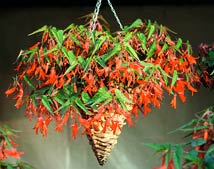8/15/2008
Success with Begonia boliviensis
Stefan Reiner
 Begonia boliviensis
Begonia boliviensis is a tuberous begonia originating from a cliff-dwelling species that is extremely water and cold sensitive. They need 14 hours of light, temperatures above 56F (13C) and high light levels, as well as constant feed with high levels of nitrogen to actively grow. They must be kept actively growing to achieve satisfying results. You should never grow them like traditional tuberous or other types of begonias. Starting them too early—when days are short and temperatures are low—will result in waterlogged, dormant plants. The later you start, the easier your crop will be to grow on and the quicker it will finish.
Propagation from unrooted cuttings
The day they arrive, stick cuttings in a disinfected propagation area. Use a slightly moistened, well-drained, aerated rooting media with a pH of 5.8 to 6.2 and EC of 1.0 to 1.5. Use paper or other preformed pots. When sticking, avoid direct contact between foliage and soil. Bottom heat is recommended. Media temperature of 72F (22C) and air temperature of 68 to 74F (20-23C) with 70 to 80 percent humidity will ensure quick and uniform rooting. Temperatures can be lowered after cuttings are well-rooted, but never let them fall below 58F (14°C).
Water cuttings slightly after sticking. Mist one to three days, avoiding saturating media. Keep cuttings somewhat dry and let wilt slightly between mists. Avoid run-off, which will leach nutrients and may cause fungal problems. If possible, mist by hand only and cover cuttings with cheesecloth. Roots should be visible after 9 to 11 days. Total rooting time is 21 to 29 days. Water in the morning; excess water will leach nutrients and raise the pH, resulting in nutrition deficiencies.
Shade cuttings for the first week at 1,500-2,000 foot-candles, which reduces transpiration. Well-established cuttings can tolerate light levels of 2,500-3,500 foot-candles.
As cuttings root, fertilize at 150 to 200 ppm N using a well-balanced fertilizer, including minor elements. Fertilize in the morning to avoid high salt levels.
Preventively drench after sticking to reduce Pythium risk. Preventive sprays combined with venting and proper water management help control Botrytis. Pests shouldn’t be a problem in a weed-free rooting area. Excessive pesticide use during rooting may result in slow, irregular rooting. Using PGRs during rooting will result in a more compact cutting. Spray B-Nine at 1,000 to 1,500 ppm or CCC at 250 to 350 ppm before cuttings stretch. Depending on variety and time of year, a second application may be necessary. Florel is not recommended. Pinch liner at third node but before fifth node develops. The vigorous variety Bellfire benefits from pinching in liner stage. Extend day length to at least 14 hours using HID lights, if possible.
Propagation from rooted cuttings
Starting from a rooted, unpinched liner, calculate 5 to 7 weeks with one plant per pot for 4- to 5-in. pots. For 10- to 12-in. baskets, calculate 8 to 10 weeks using four to five plants per pot. For gallons, use two plants per pot with 7 to 9 weeks to finish, pinching twice.
Use a rooting media as described above. Slightly moisten finish media and thoroughly water rooted cuttings before transplanting. Plant one liner into the pot deep enough so rooting media is level with media in container. After roots develop, maintain night temperatures of 56-60F (14 to 16C) and day temperatures of 65-75F (18 to 24C). Toward the crop’s end, lower temperature further to 56 to 60F (14 to 16C) day and night. Keep humidity below 70 percent.
Further critical points for finishing:
• Provide horizontal airflow to help prevent diseases.
• High light levels (4,000 to 5,000 foot candles) during finish promote compact growth.
• Pinch about one week after transplant to about three nodes, but never let plant develop its fifth node as this will lead to dormancy.
• Proper water management, pH, air circulation and soil porosity will help alleviate problems.
Stefan Reiner is general manager for Selecta First Class, Inc.